Striking Ancient Stone Idols: The Forgotten Polovtsian Statues Of Eastern Europe
Ellen Lloyd – AncientPages.com - These enigmatic ancient stone statues, or "stone idols," as they are often called by locals, are almost unknown to the outside world.
The statues, known as the "Polovtsian statues," are found in large numbers spread across Russia, southern Siberia, eastern Ukraine, Germany, Central Asia, and Mongolia.
Polovtsian statues. Credit: Adobe Stock - Andrey
Many of the Polovtsian statues represent male warriors wearing helmets, armor, and weapons, like swords, bows, and quivers. Hats and purses can be seen on the female statues.
In 2008, a team of archaeologists and conservators from Poland and the Czech Republic undertook maintenance work on the Polovtsian anthropomorphic late medieval steles from the collection of the Veliklanadolskyi Forest Museum at Komsomolsky Podsiolok in East Ukraine.
Their goal was to prevent the degradation of the sculptures caused by environmental factors and human activities, as well as to restore the aesthetics of the statues.
The stele "baba 2" from the Veliko-Anadol Forest Museum (cf Pletneva, 1974a. 152. No.302. Illustration from "Monumental Polovtsian Statues in Eastern Europe: The Archaeology, Conservation and Protection" By Aneta Golebiowska-Tobiasz
Aneta Golebiowska-Tobiasz, a member of the team, became strongly aware of the cultural value of the monumental sculptures - barely known in the rest of Europe and decided to channel her efforts into research and the restoration of the stelae, which represent so majestically the cultural heritage of the Turkic people of the steppe zone of Eastern Europe.
De Gruyter Open has now published the "Monumental Polovtsian Statues in Eastern Europe. The Archaeology, Conservation and Protection" in its Open Access Book program, presenting the author's well-documented and illustrated history of the research on Cuman stone stelae.
"Stone statues, indigenous to the early Turks, appeared in the vast territory of the Asian steppes, from Southern Siberia to Central Asia and across the foothills of the Ural Mountains. The custom originated among Cumans in Eastern Europe.
The skill of erecting anthropomorphic stelae required proficiency in processing different kinds of stone and wood, and was characterized by artistic value of representations, as well as by the timeless aesthetics of the canon," researchers write in their book "Monumental Polovtsian Statues in Eastern Europe. The Archaeology, Conservation and Protection".
Polovtsian statues in Ukraine. Credit: Adobe Stock - fotomaster
The art of creating stelae had been known in many cultural circles before it had appeared among the Turkic peoples. The tradition of constructing monumental stone sculptures originated in the Bronze Age cultures of Central and Middle Asia around the 4th millennium B.C. The Kimmers and the Scythians later created anthropomorphic stelae.
Stone statues associated with the early Turks appeared in a vast territory of the Asian steppes that stretches from the Southern foothills of the Ural Mountains through Kazakhstan to Mongolia.
Their origin and cultural significance are interpreted in various ways, and still many issues associated with their construction remain unclear.
The book delves into the phenomenon of anthropomorphic sculptures in relation to the migration of the Turkic nomads from the perspective of an archaeologist and conservator.
With a visibly palpable passion, Gołębiowska-Tobiasz explores the diffusion of the stale evolution of their canon, addressing alongside the latest hypothesis of the sculptures being related to religious beliefs and their possible political significance.
The art of erecting stale disappeared rather abruptly with the fall of the Polovtsians and the rapid spread of Islam. This book will mark a new perspective for archaeologists and historians on the most versatile aspects of these imposing and yet neglected monuments.
"The book is not only innovative," says Igor Leonidovich Kyzlasov, Head of Medieval Archaeology at the Russian Academy of Sciences, and arguably, one of the finest scientists in this subject area, "but it also accurately documents the complex process, and the results of restoration and conservation of monuments."
Polovtsian statues in Ukraine. Credit: Adobe Stock - olyasolodenko
According to Past Horizons, "The Polovtsians conquered the area of the Azov steppes relatively early in the 11th century AD. The rich pastures and abundance of water in the new sprawling land under their control ensured the groups moved from nomadism towards seasonal horse pastoralism within a closed cycle of encampments.
In addition to favorable environmental conditions, the density of old kurgan cemeteries located in the watersheds of rivers played a crucial role.
The Polovtsians used these previously erected mounds as burial or cult places, often putting anthropomorphic statues on their summits. In this way, they used the already sacred spaces during both funeral ceremonies."
Hopefully, the forgotten and neglected Polovtsian statues will now be better preserved for future generations. It would be a great pity if valuable history was lost again.
Updated on March 20, 2024
Written by - Ellen Lloyd – AncientPages.com
Copyright © AncientPages.com All rights reserved. This material may not be published, broadcast, rewritten or redistributed in whole or part without the express written permission of AncientPages.com
More From Ancient Pages
-
 Ancient DNA Reconstructs Rise Of Largest Empires In History Of Inner Asia
Archaeology | Nov 6, 2020
Ancient DNA Reconstructs Rise Of Largest Empires In History Of Inner Asia
Archaeology | Nov 6, 2020 -
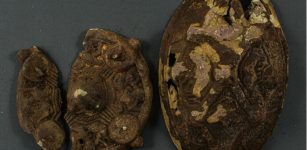 Family Looking For Lost Gold Ring Finds Viking Age Artifacts In Their Garden On The Island Of Jomfruland
Archaeology | Sep 30, 2023
Family Looking For Lost Gold Ring Finds Viking Age Artifacts In Their Garden On The Island Of Jomfruland
Archaeology | Sep 30, 2023 -
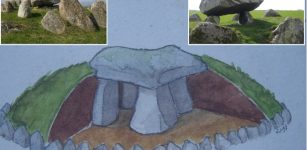 Skegriedösen (Skegrie Dolmen) – 5,000-Year-Old Stone Chamber Tomb In Southern Sweden
Featured Stories | Feb 11, 2023
Skegriedösen (Skegrie Dolmen) – 5,000-Year-Old Stone Chamber Tomb In Southern Sweden
Featured Stories | Feb 11, 2023 -
 19 Cannons Shot From British Ships During The American Revolution Discovered In Savannah River
Archaeology | Apr 29, 2022
19 Cannons Shot From British Ships During The American Revolution Discovered In Savannah River
Archaeology | Apr 29, 2022 -
 Were Neanderthals Really As Well Adapted To A Life In The Cold As Previously Assumed? New Study
Archaeology | Apr 26, 2022
Were Neanderthals Really As Well Adapted To A Life In The Cold As Previously Assumed? New Study
Archaeology | Apr 26, 2022 -
 Strange Case Of The Italian Doppelganger – Collision Of Parallel Timelines? Part 2
Featured Stories | Oct 16, 2019
Strange Case Of The Italian Doppelganger – Collision Of Parallel Timelines? Part 2
Featured Stories | Oct 16, 2019 -
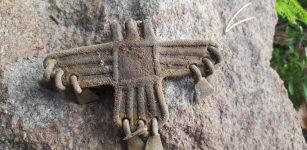 Unique Ancient Three-Headed Eagle Pendant Discovered In Finland: A Symbol Of Three Different Human Souls
Ancient Symbols | May 6, 2016
Unique Ancient Three-Headed Eagle Pendant Discovered In Finland: A Symbol Of Three Different Human Souls
Ancient Symbols | May 6, 2016 -
 Are Priceless Ancient Gold Tablets Of The Serpent People Hidden Underground In Los Angeles?
Ancient Mysteries | May 24, 2014
Are Priceless Ancient Gold Tablets Of The Serpent People Hidden Underground In Los Angeles?
Ancient Mysteries | May 24, 2014 -
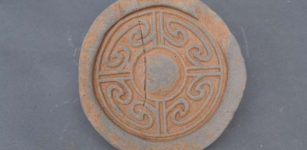 Discovered Inscription On Ancient Stone Vessel Reveals Location Of Legendary Tomb Of Chinese Emperor
Archaeology | Jan 11, 2021
Discovered Inscription On Ancient Stone Vessel Reveals Location Of Legendary Tomb Of Chinese Emperor
Archaeology | Jan 11, 2021 -
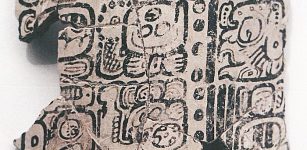 Painted Komkom Vase With Longest Hieroglyphic Text Unearthed In Belize
Archaeology | Apr 24, 2019
Painted Komkom Vase With Longest Hieroglyphic Text Unearthed In Belize
Archaeology | Apr 24, 2019 -
 Rare Neolithic Underwater Textiles And Dwellings Discovered At La Marmotta Near Rome
Archaeology | Jun 6, 2023
Rare Neolithic Underwater Textiles And Dwellings Discovered At La Marmotta Near Rome
Archaeology | Jun 6, 2023 -
 On This Day In History: Supernova Observed In Constellation Lupus By Chinese And Egyptians – On May 1, 1006 AD
News | May 1, 2016
On This Day In History: Supernova Observed In Constellation Lupus By Chinese And Egyptians – On May 1, 1006 AD
News | May 1, 2016 -
 Viking Age Mass Grave Reveals Gruesome Discovery At Historical Village Of Repton, England
Archaeology | Feb 4, 2018
Viking Age Mass Grave Reveals Gruesome Discovery At Historical Village Of Repton, England
Archaeology | Feb 4, 2018 -
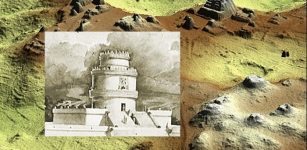 Mysterious El Caracol At Chichen Itza: What Did Maya Astronomer-Priests Observe In The Sky?
Archaeoastronomy | May 24, 2019
Mysterious El Caracol At Chichen Itza: What Did Maya Astronomer-Priests Observe In The Sky?
Archaeoastronomy | May 24, 2019 -
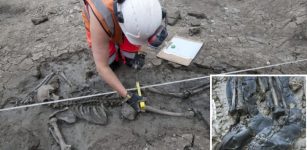 Medieval Mystery Of The Booted Man Found In The Thames Mud
Archaeology | Dec 10, 2018
Medieval Mystery Of The Booted Man Found In The Thames Mud
Archaeology | Dec 10, 2018 -
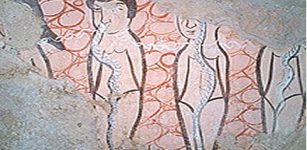 Ancient Monastery In The Middle Of ‘Syria’s Stonehenge’ – Underground Caves, Tombs, Stone Circles Older Than Pyramids
Civilizations | Nov 13, 2015
Ancient Monastery In The Middle Of ‘Syria’s Stonehenge’ – Underground Caves, Tombs, Stone Circles Older Than Pyramids
Civilizations | Nov 13, 2015 -
 Kava – Astonishing Ancient Plant That Improves Emotional Intelligence Is Gaining Popularity In The Western World
Featured Stories | Mar 31, 2018
Kava – Astonishing Ancient Plant That Improves Emotional Intelligence Is Gaining Popularity In The Western World
Featured Stories | Mar 31, 2018 -
 A 2,500-Year-Old Planned City In Tarighat, Chhattisgarh, India
Civilizations | Oct 8, 2014
A 2,500-Year-Old Planned City In Tarighat, Chhattisgarh, India
Civilizations | Oct 8, 2014 -
 Papyri Was Still In Use After The Arab Invasion In Egypt
Archaeology | Jul 14, 2020
Papyri Was Still In Use After The Arab Invasion In Egypt
Archaeology | Jul 14, 2020 -
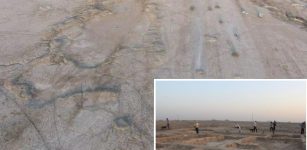 Large 4,000-Year-Old Sumerian Port Discovered In The Desert In Iraq
Archaeology | Apr 4, 2018
Large 4,000-Year-Old Sumerian Port Discovered In The Desert In Iraq
Archaeology | Apr 4, 2018




